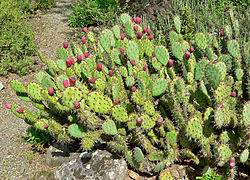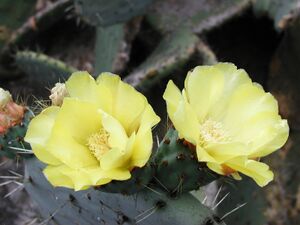Opuntia
| Opuntia subsp. var. | prickly pear, paddle cactus, nopales | |||||||||||||||||||||||||||||||||||||||||||||||||||||||
|---|---|---|---|---|---|---|---|---|---|---|---|---|---|---|---|---|---|---|---|---|---|---|---|---|---|---|---|---|---|---|---|---|---|---|---|---|---|---|---|---|---|---|---|---|---|---|---|---|---|---|---|---|---|---|---|---|

|
|
| ||||||||||||||||||||||||||||||||||||||||||||||||||||||
| ||||||||||||||||||||||||||||||||||||||||||||||||||||||||
Opuntia, also known as nopales (see below), or Paddle Cactus from the resemblance to the ball-and-paddle toy, is a genus in the cactus family, Cactaceae.
Currently, only prickly pears are included in this genus of about 200[1] species distributed throughout most of the Americas. Chollas are now separated into the genus Cylindropuntia, which some still consider a subgenus of Opuntia. Austrocylindropuntia, Corynopuntia and Micropuntia are also often included in the present genus, but like Cylindropuntia they seem rather well distinct. Brasiliopuntia and Miqueliopuntia are closer relatives of Opuntia.
The most commonly culinary species is the Indian Fig Opuntia (O. ficus-indica). Most culinary uses of the term 'prickly pear' refer to this species. Prickly pears are also known as tuna, nopal or nopales, from the Nahuatl word nōpalli for the pads, or nostle, from the Nahuatl word nōchtli for the fruit; or paddle cactus (from the resemblance to the ball-and-paddle toy). They are native to Mexico.

Prickly pear cacti typically grow with flat, rounded platyclades that are armed with two kinds of spines; large, smooth, fixed spines and small, hairlike spines called glochids that easily penetrate skin and detach from the plant. Many types of prickly pears grow into dense, tangled structures.
Like all true cactus species, prickly pears are native only to the Western hemisphere; however, they have been introduced to other parts of the globe.
Opuntia are the most cold-tolerant of the lowland cacti, extending into western and southern Canada; one subspecies, Opuntia fragilis var. fragilis, has been found growing along the Beatton River in central British Columbia, southwest of Cecil Lake at 56° 17’ N latitude and 120° 39’ W longitude.[2] Prickly Pears also give a fruit that is commonly eaten in Mexico, known as "Tuna", also used to make Aguas frescas. The fruit can be red, wine-red, green or yellow-orange.
Charles Darwin was the first to note that these cacti have thigmotactic anthers: when the anthers are touched, they curl over, depositing their pollen. This movement can be seen by gently poking the anthers of an open Opuntia flower. The same trait has evolved convergently in other cacti (e.g. Lophophora).
| Standard Cyclopedia of Horticulture |
|---|
|
Nopalea (from the Mexican name of the cochineal cactus). Cactaceae. A genus of 4 or 5 species, often placed with the opuntias, but differing from the latter in having erect petals, and stamens and style exsert beyond the perianth, as well as in some minor details. Natives of Trop. Amer. N. coccinellifera, Salm- Dyck (N. inaperta, Schott). An arborescent, flat- stemmed plant, with a somewhat cylindrical trunk 6-10 in. diam., widely grown in semi-tropical countries, but rarely found in the U. S., and then only in the largest collections of cacti. It is chiefly interesting in being one of the important food-plants of the cochineal insect. B.M. 2741. 2742 (as Cactus cochinellifer). N. guatemalensis and N. lutea are 2 recently described species from Guatemala which have been intro. into cult.
|
Cultivation
Propagation
Pests and diseases
Species
Selected species== Opuntia hybridizes readily between species.[3] This can make classification difficult. Also, not all species listed here may actually belong into this genus.


Opuntia fragilis




Opuntia polycantha


- Opuntia aciculata
- Opuntia anacantha
- Opuntia atrispina
- Opuntia auberi
- Opuntia aurantiaca
- Opuntia basilaris – Beavertail cactus
- Opuntia boldinghii
- Opuntia chaffeyi
- Opuntia chlorotica – Pancake Prickly Pear; native to southwest USA and the Sonoran and Mojave deserts.
- Opuntia clavata
- Opuntia cochenillifera
- Opuntia comonduensis
- Opuntia compressa
- Opuntia curvospina
- Opuntia decumana
- Opuntia decumbens – Nopal de Culebra
- Opuntia dejecta
- Opuntia echios
- Opuntia echios var. gigantea – Galápagos prickly pear. Galápagos Islands.
- Opuntia elata
- Opuntia elatior Mill. – syn. O. bergeriana
- Opuntia engelmannii – Engelmann's Prickly Pear, Cow's-tongue Prickly Pear, Desert Prickly Pear, Discus Prickly Pear, Texas Prickly Pear, calico cactus
- Opuntia erinacea
- Opuntia exaltata
- Opuntia excelsa
- Opuntia ficus-barbarica
- Opuntia ficus-indica – Indian Fig Opuntia
- Opuntia fragilis – Little Prickly Pear, brittle cactus. Found in the Great Plains and as far west as British Columbia.
- Opuntia galapageia
- Opuntia gosseliniana – Violet Prickly Pear
- Opuntia gosseliniana var. santa-rita – Santa Rita Prickly Pear
- Opuntia helleri
- Opuntia hickenii
- Opuntia humifusa – Eastern Prickly Pear (sometimes included in O. compressa)
- Opuntia hyptiacantha
- Opuntia inamoema K. Schum. – quipá
- Opuntia insularis
- Opuntia invicta
- Opuntia jamaicensis
- Opuntia laevis
- Opuntia lasiacantha
- Opuntia leucotricha – Arborescent Prickly Pear, Aaron's beard cactus, semaphore cactus, Duraznillo blanco, Nopal blanco
- Opuntia lindheimeri
- Opuntia littoralis – Sprawling Prickly Pear
- Opuntia longispina
- Opuntia macbridei
- Opuntia macrocentra – Black-spine Prickly Pear, Purple Prickly Pear. Found in southwest USA and northern Mexico.
- Opuntia macrorhiza – Plains Prickly Pear. Found throughout the Great Plains except for the northernmost areas (not found in North Dakota), and extending sporadically eastward as far as Kentucky. Syn. O. leptocarpa MacKensen, O. tenuispina Engelm., O. tortispina Engelm. & Bigelow
- Opuntia maldonandensis
- Opuntia maxima
- Opuntia megacantha
- Opuntia megarrhiza
- Opuntia megasperma
- Opuntia microdasys – Bunny ears cactus, Polka-dot cactus
- Opuntia monacantha – Common Prickly Pear
- Opuntia oricola
- Opuntia ovata
- Opuntia pachypus
- Opuntia pachyrrhiza
- Opuntia phaeacantha – Tulip Prickly Pear. Includes Plateau Prickly Pear, Brown-spined Prickly Pear, Mojave Prickly Pear, Kingman Prickly Pear.
- Opuntia pinkavae – Pinkava's Prickly Pear
- Opuntia polyacantha – Panhandle Prickly Pear. Found in the Great Plains, Great Basin, Mojave Desert, Colorado Plateau, and the Rocky Mountains. Syn. O. rhodantha K.Schum.
- Opuntia polyacantha var. arenaria (syn. O. erinacea)
- Opuntia pubescens (syn. O. pascoensis Britton & Rose)
- Opuntia pusilla – Creeping cactus. Syn. O. drummondii Graham
- Opuntia rastrera
- Opuntia repens
- Opuntia robusta
- Opuntia rufida (sometimes included in O. microdasys)
- Opuntia saxicola
- Opuntia schumannii
- Opuntia soehrensii
- Opuntia stenopetala (syn. O. riviereana Backeb.)
- Opuntia streptacantha
- Opuntia stricta – Erect Prickly Pear, Spineless Prickly Pear, Coastal Prickly Pear
- Opuntia subulata – found in South America
- Opuntia sulphurea
- Opuntia taylori
- Opuntia tehuantepecana – Nopal de Caballo
- Opuntia tomentosa – Woollyjoint Prickly Pear
- Opuntia triacantha
- Opuntia tuna
- Opuntia velutina
- Opuntia violacea
Gallery
-
photo 1
-
photo 2
-
photo 3

|

|

|

|
| Bud appears ► | Bud grows ► | Bud grows more► | Bud grows yet more► |

|

|

|
| Pad continues growth ► | Edible pad (tender) ► | Mature pad |
References
- ↑ Jon P. Rebman, Ph.D., "What has happened to Opuntia?" San Diego Natural History Museum
- ↑ Cota-Sánchez (2002)
- ↑ Cite error: Invalid
<ref>tag; no text was provided for refs namedgriffith2004
- Standard Cyclopedia of Horticulture, by L. H. Bailey, MacMillan Co., 1963
External links
- w:Opuntia. Some of the material on this page may be from Wikipedia, under the Creative Commons license.
- Opuntia QR Code (Size 50, 100, 200, 500)
